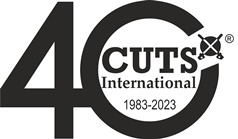June 16, 2006, The Hindu
Jaipur, India
Special Correspondent
- Improvement in quality of education and health of students
- Drop-out rate also falls but marginally
- 92-95 per cent of the students have meals at schools
The much- talked about mid-day meals scheme introduced in Rajasthan in the Government and Government-aided primary schools has had an affirmative effect on enrolment of children, particularly of the girl child, at the elementary level. It has helped improve the quality of education as well as the health of students, besides helping the families to tide over the problems of hunger and malnutrition, a new study has indicated.
A participatory expenditure tracking survey on the scheme in the district of Chittorgarh in Rajasthan, conducted by CUTS-Centre for Consumer Action, Research and Training (CUTS-CART) in association with the World Bank reported improvement of enrolment in 64 per cent of the schools and improvement in retention in 51 per cent schools in past three years. The enrolment of girls registered an increase in 58 per cent of the schools surveyed while it was found that quality of education improved in 49 per cent of them.
The survey results were presented at a State- level dissemination meeting before experts, World Bank representatives, JVR Murty, Vinod Sahagal, MLAs, C.P.Joshi, Chairman of the Public Accounts Committee and Nathu Singh Gujjar, besides Rajendra Bhanawat, Divisional Commissioner, Jaipur, Saroj Punhani, Accountant General (Audit), Jaipur, Sarathi Acharya, director of the Institute of Development Studies, Jaipur and former director S.S.Acharya.
Presenting the findings, the survey team leaders, K.C. Sharma and Dhudeshwar Kumar, however noted the decline in lifting of foodgrains by the State Government in the past three years. The off take of foodgrains was 67 per cent on an average during the period against the total grains sanctioned by the Centre. The unutilised fund (conversion cost) remaining with the districts had steadily increased from 27 per cent to 71 per cent during 2001-02 to 2004-05, they noted.
However, the dropout rate among children from Class I to Class VIII in the district in 2005-06 had been a little less at 37.12 per cent compared to 39.85 at the State level. Chittorgarh, on the other hand, had a wider gender gap at 11.56 per cent in the same category of children against 10.71 per cent at State level in 2005-06.
On the flip side again was the number of cooks employed for preparing the mid-day meals which stood at 7 and 6 per cent from Scheduled Tribes and Scheduled Castes, respectively, though the Supreme Court had issued a directive asking to give preference of SC/ST cooks. A maximum, 64 per cent cooks, belonged to the backward communities while the forward castes accounted for 23 per cent.
The survey found the quality of food served in the schools to the liking of the parents and the children. About 92-95 per cent of the students ate the mid-day meals at school and found it satisfying both qualitatively and in quantity.
The State had initially started the mid-day meals with “googri” or boiled wheat with either salt or jaggery. It started providing variety from April 2005 under the new guidelines of the Supreme Court. Under the guidelines, roti-subzi, roti-dal, puri-sabzi, mithe chawal, namkeen chawal, khichri, mitha daliya, namkeen daliya, lapsi and dal-chawal are in the menu.
Earlier the Centre was providing Re.1 per student as cooking conversion cost against 50 paise from the State Government. In the current session (2006-07), the Rajasthan Government has increased its contribution to Re.1.
This news can also be read at following URL:
http://www.hindu.com/2006/06/16/stories/2006061613280500.htm
